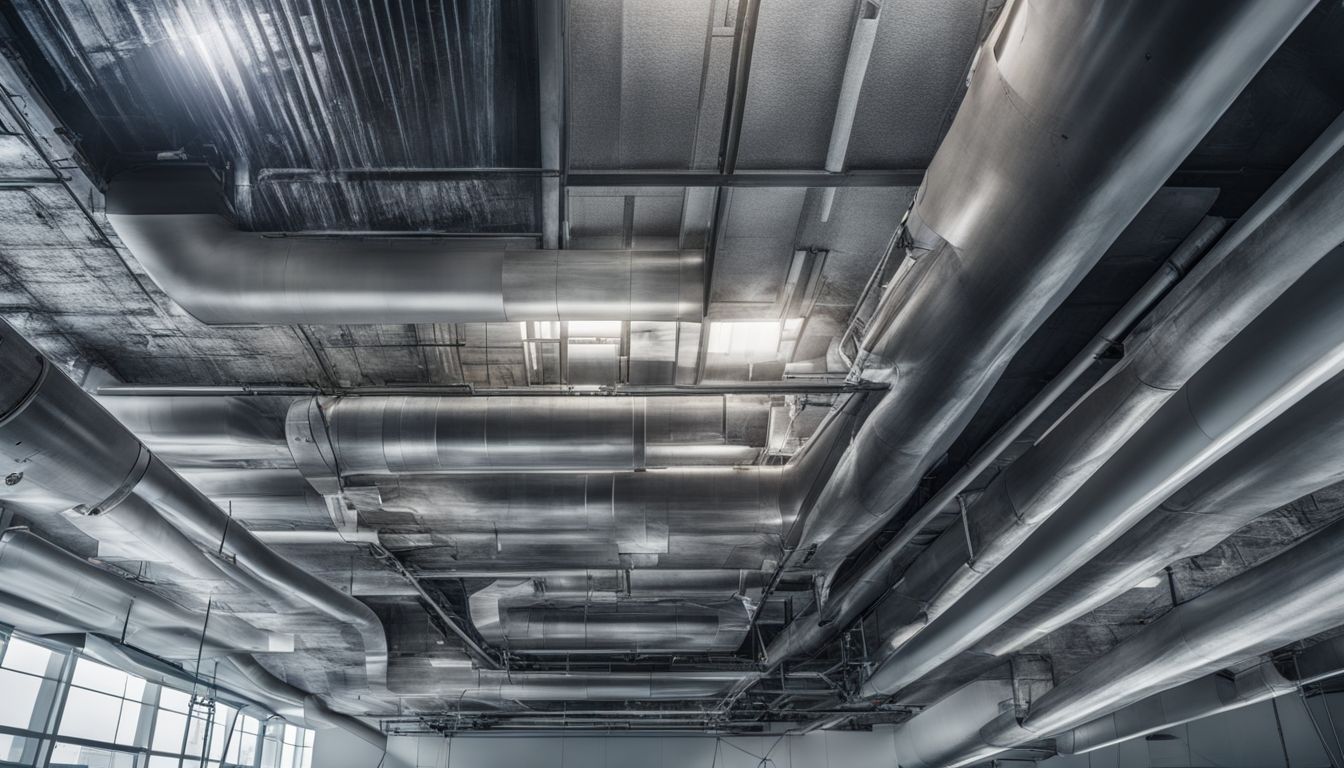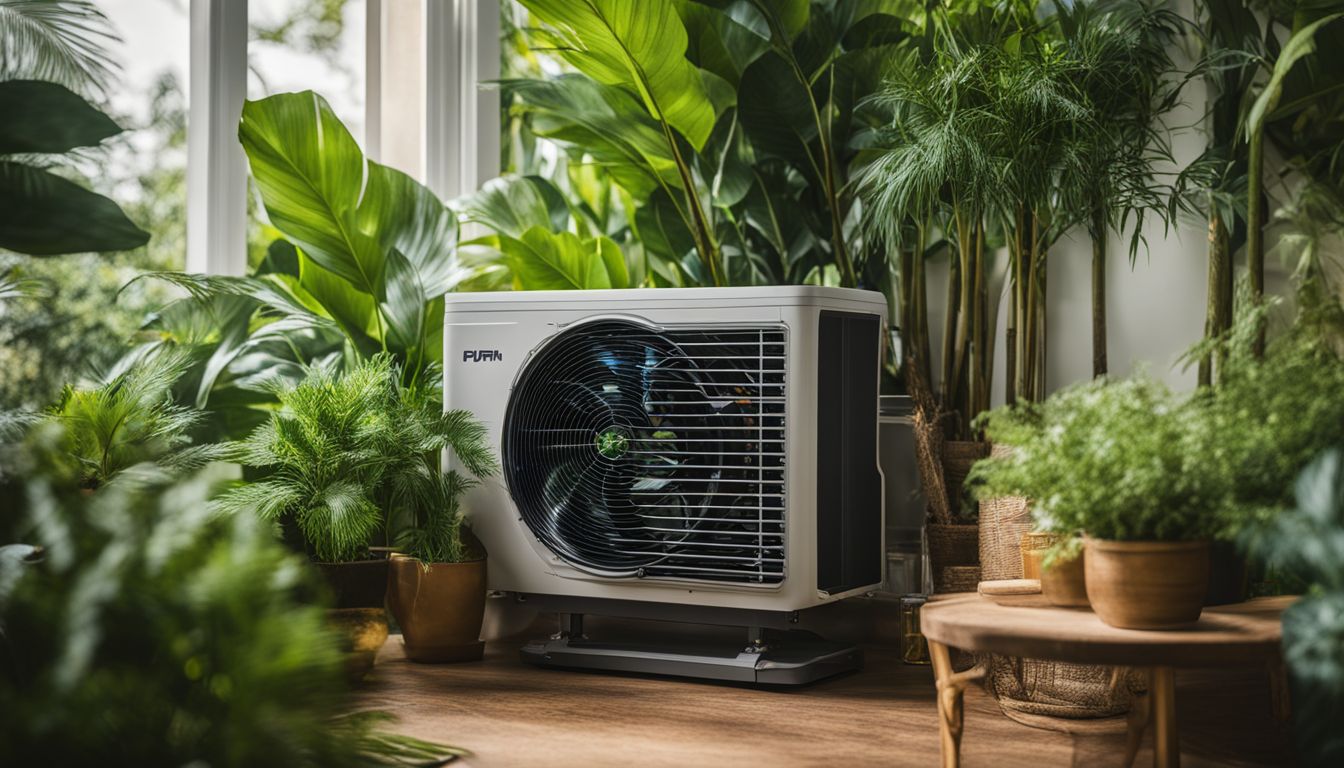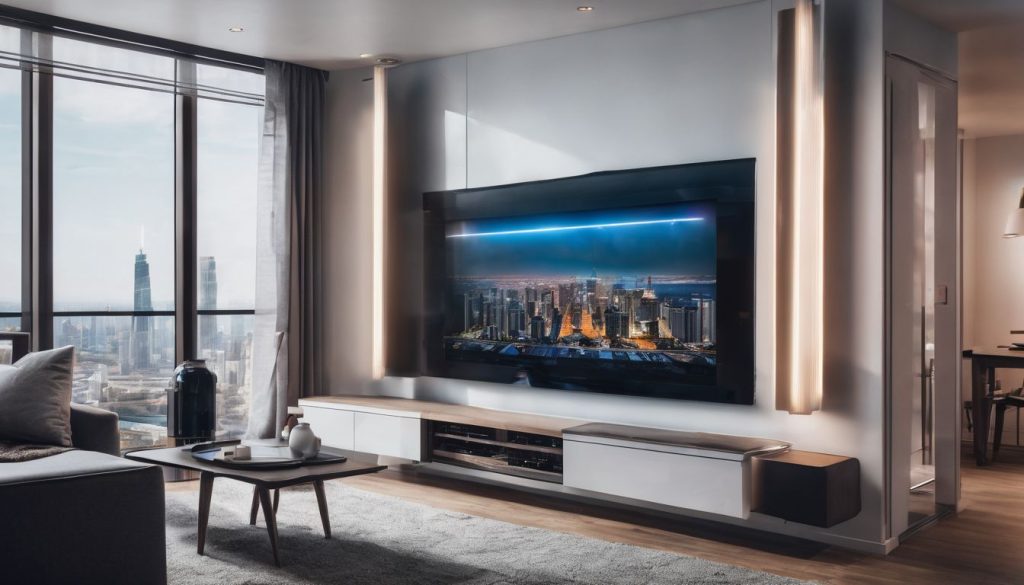As temperatures soar worldwide, the demand for air conditioning becomes a key concern in our daily comfort and survival. Interestingly, nearly one-fifth of the energy used in buildings is just to keep us cool.
Our detailed blog post will explore how modern air conditioning is evolving, bringing smarter and less resource-intensive solutions your way. Keep reading to discover what keeps you cool without heating up the planet.
Current Status of the Air-Conditioning Market
The air-conditioning market is experiencing dynamic expansion, driven by technological innovation and increasing global demand for cooling solutions. Major industry players are competing fiercely to capitalise on this growth, continuously adapting their offerings to meet the evolving needs of residential and commercial users.
Key Producers and Market Leaders
Understanding the air conditioning industry’s key producers and market leaders is vital for predicting its future direction. These entities play a significant role in innovation, production capacity, and market trends.
| Company | Headquarters | Market Position | Notable Contributions |
|---|---|---|---|
| Daikin Industries | Osaka, Japan | Industry Leader | Daikin is known for its innovation in energy-efficient and environmentally friendly air conditioning systems. |
| Carrier Global Corporation | Palm Beach Gardens, USA | Top Manufacturer | Carrier excels in producing a wide range of high-quality residential and commercial air conditioning units. |
| LG Electronics | Seoul, South Korea | Market Innovator | LG is recognised for its smart and connected air conditioning solutions, leading the trend towards intelligent systems. |
| Midea Group | Foshan, China | Major Player | Midea has significantly expanded its global presence, offering competitively priced and technologically advanced air conditioners. |
| Johnson Controls – Hitachi Air Conditioning | Wisconsin, USA | Key Innovator | The joint venture has pushed forward with advanced HVAC technologies that promise greater efficiency. |
| Gree Electric Appliances | Zhuhai, China | Large Market Share | Gree has a strong focus on producing user-friendly air conditioners while maintaining high efficiency. |
| Haier Smart Home | Qingdao, China | Global Distributor | Haier’s air conditioning systems are widely recognised for their smart features and ease of use. |
| Trane Technologies | Swords, Ireland | Technology Leader | Trane is renowned for its durable and reliable climate control solutions for residential and commercial markets. |
China’s significant production of air conditioners, particularly by large corporations like Midea and Gree, indicates their pivotal role in shaping the industry’s future. Market leaders such as Daikin and Carrier are equally influential, driving advancements in energy efficiency and smart technology integration. These companies will likely continue to dominate and innovate in the air conditioning market, setting trends that will define the landscape for years.
Segmentation by Type

The air conditioning market is categorised by various types, catering to specific needs and preferences across different applications. Here is a summary of the segmentation by type presented in an HTML table format:
| Type | Description | Common Applications |
|---|---|---|
| Central Air Conditioning | Systems designed for cooling large spaces through a network of ducts. | Commercial, Institutional |
| Split Air Conditioning | Units with separate indoor and outdoor components, minimizing internal noise. | Residential, Small Commercial |
| Window Air Conditioning | Compact units that fit in window spaces, suitable for small rooms. | Residential, Small Offices |
| Portable Air Conditioning | Mobile units that can be moved from room to room, offering flexibility. | Residential, Temporary Spaces |
| Hybrid Air Conditioning | Systems that combine different technologies to optimize energy consumption. | Residential, Eco-conscious Spaces |
| Geothermal Air Conditioning | Units utilizing the stable temperature of the ground to enhance efficiency. | Residential, Sustainable Developments |
This table provides a snapshot of the air conditioning market’s segmentation by type, indicating a move towards more targeted and specialized air conditioning solutions. Each type serves specific segments within the residential, commercial, and institutional applications, demonstrating the market’s diverse offering to accommodate varying consumer needs.
Segmentation by Application
Air conditioning systems find widespread applications across various sectors. These sectors can be neatly categorised to reflect the market segmentation by application. Below is a table outlining these categories:
| Segment | Applications |
|---|---|
| Residential | Households and residential buildings |
| Commercial | Business establishments, retail stores, and entertainment venues |
| Institutional | Schools, hospitals, government buildings |
| Industrial | Manufacturing plants, warehouses, data centers |
| Others | Transport vehicles, temporary structures |
Each segment utilises air conditioning for comfort, process requirements, or both. Market analysis reveals detailed insights when dissecting these segments by region and specific application needs.
Future Predictions for the Air-Conditioning Market
As we look to the horizon of indoor climate control, the air-conditioning market is poised for a transformative evolution. Innovative technologies and smart systems are set to redefine comfort, efficiency, and sustainability in our living and working environments.
Emerging Technologies
Emerging technologies in the HVAC sector are changing how we cool our environments. Predictive maintenance is taking centre stage, allowing smart systems monitoring to pre-empt breakdowns and reduce downtime.
This innovative approach uses data analytics to track performance and foresee potential issues before they arise.
Innovation doesn’t stop there—new energy sources are being integrated into air conditioning units to lessen their carbon footprint. Advances such as heat pump technology, which can both cool and dehumidify spaces more efficiently, show promise in reducing the energy-intensive process of traditional HVAC systems.
Adopting these high-tech solutions is reshaping business strategies within the industry, driving towards a future where comfort doesn’t come at the cost of climate change.
The Rise of Smart Air Conditioning Systems

Smart air conditioning systems are transforming the way we cool our spaces. These advanced units integrate AI and IoT technology, allowing users to control temperatures remotely with their smartphones or voice commands.
Homeowners and businesses now seek these smart systems for convenience and energy efficiency. They learn usage patterns over time, automate settings based on preferences, and can even alert users about necessary maintenance.
Market analysts predict a bright future for this sector, expecting the smart air conditioning market to soar to USD 46.39 billion by 2032. This surge is driven by consumers’ increasing appetite for devices that offer both sophistication and savings on energy bills.
Smart air conditioners represent a quantum leap from traditional models as they provide real-time data analytics, enabling proactive adjustments in cooling without human intervention—an appealing upgrade in an ever-connected world.
Anticipated Market Trends
Experts predict a significant shift towards energy-efficient air conditioning systems, driven by rising electricity costs and increasing environmental awareness. Manufacturers are expected to innovate aggressively to meet stringent efficiency standards globally.
As market dynamics evolve, we’ll see more air conditioners equipped with smart technology that can adapt to usage patterns and integrate seamlessly with other home automation systems.
The desire for customisable cooling solutions will shape the future of AC units. Consumers are looking for models that offer not only comfort but also health benefits, such as better air filtration to improve indoor air quality.
The competition among producers will heat up as they scramble to cater to these new demands while balancing the need for cost-effective production methods. Expect companies that harness renewable energies in their operations or develop innovative cooling technologies like evaporative coolers and dehumidification systems to gain a competitive edge in this rapidly changing marketplace.
Potential Challenges
Manufacturers may struggle to keep up as the global air conditioner market expands rapidly, with projections indicating a surge to multimillion figures by 2030. Supply chains could become strained as they try to meet the rising demand spurred by increases in global temperatures and personal incomes.
This growth might also worsen economic disparities if access to cooling technology remains uneven worldwide.
Energy systems must adapt quickly, integrating renewable sources and improving efficiencies to sustain market growth without exacerbating climate-warming emissions from an overreliance on traditional power generation methods.
The Role of Efficiency in Future Air-Conditioning

As the global thermostat climbs, the ingenious evolution of air-conditioning pivots towards efficiency; this industry shift is not only an environmental imperative but a gateway to unprecedented energy savings for consumers across the globe.
Embracing these efficient models signifies a substantial stride toward curbing our collective carbon footprint and harmonising with the planet’s finite resources.
The Need for Energy-Efficient Models
Energy efficiency is no longer just a buzzword in the air conditioning industry; it’s become essential for lowering electricity demand and managing peak power loads. Efficient AC models are pivotal as they can halve cooling energy needs by 45% compared to standard systems.
This significant reduction emerges from advancements that heighten seasonal energy efficiency ratios, mitigating stress on power plants and contributing to global efforts against CO2 emissions.
Businesses and homeowners benefit substantially from investing in energy-efficient air conditioners (ACs). These innovative appliances require less electricity, directly translating into cost savings and reducing carbon intensity.
Additionally, optimised performance aligns with international building regulations designed to promote sustainability. By adopting efficient models, users support a greener economy while benefiting from reduced operational costs over the lifespan of their AC units.
The Potential for Savings with Improved Efficiency
Improving the efficiency of air conditioners means people can enjoy cool, comfortable spaces without cranking up their energy bills through the roof. Innovations in technology and design promise to cut down cooling costs significantly.
If we double average AC efficiency, it’s possible to slash cooling energy demand by a whopping 45%, freeing up resources for other important needs.
Households and businesses stand to save big with these advances. Imagine shaving off 10-15% of your annual spending on air conditioning alone – that’s more money in your pocket each year.
Such savings could transform budgeting plans and help direct funds towards further improving building designs or investing in renewable power sources. These are not just numbers; they represent a powerful ripple effect across economies, bolstering growth while mitigating the impacts of global warming.
The Impact of Air-Conditioning on Global Energy Demand
As global temperatures rise, so does the reliance on air-conditioning, intensifying its worldwide energy consumption footprint. This burgeoning demand poses a significant challenge and a catalyst for innovation within the energy sector.
Current Contribution to Electricity Demand
Air conditioning systems gulp down a substantial share of energy, with nearly 20% of the electricity in buildings consumed by these cooling solutions. This hefty usage contributes significantly to peak electricity demand, especially during heat waves when everyone cranks their air conditioners for relief.
Market research indicates this trend is not slowing down; it’s accelerating alongside economic growth and rising temperatures globally.
With insights from the International Energy Agency (IEA), it’s clear that air-conditioned comforts are no longer just luxury items but have become integral to modern living. This surge in consumption poses a challenge as nations strive to balance increasing demand with sustainable energy sources and efficiency standards.
Electricity grids feel the strain as more homes and offices turn on their units to escape the heat. This highlights the critical need for innovations like smart systems and passive cooling strategies to mitigate this growing impact on global energy resources.
Predicted Growth in Demand
The thirst for cool air is igniting a surge in the market, with experts foreseeing an almost threefold leap by 2050 in electricity consumption for air conditioning alone. Reports from the International Energy Agency indicate that the energy hunger of cooling systems will skyrocket, reaching a staggering 6,205 terawatt-hours.
This voracious appetite highlights a rise in global temperature. Population and wealth increase, particularly within emerging countries where hot climates and rising per capita GDP create fertile ground for booming AC sales.
As nations develop, their demand for comfort drives investment in heating and cooling solutions. Air-conditioning units are set to become more than just appliances; they’re becoming essential components of modern living across diverse geographies.
With this projected expansion comes the imperative need to advance technology and efficiency standards to curb what could otherwise be unchecked growth contributing massively to greenhouse gas emissions.
The push towards environmentally sustainable refrigerants and improved insulation materials stands as key factors that can shape how we meet our cooling needs without overburdening our planet’s resources.
Conclusion
Innovation holds the key to a cooler, more sustainable future. As we advance, smarter and greener air conditioning technologies will be crucial in reducing energy use. Producers are set to meet rising global demand while tackling environmental challenges head-on.
Expectations run high for ground-breaking systems that promise both comfort and conservation. A fresh wave of progress signals exciting times ahead for air conditioning advancements.
Discover how intelligent HVAC solutions transform comfort and efficiency in our homes and offices by exploring the rise of smart air conditioning systems.
FAQs
1. What new air-conditioning systems are we expecting to see?
Innovative air-conditioning systems like swamp coolers, evaporative cooling units, and heat pumps that focus on energy efficiencies may become more common.
2. How will green technologies shape the future of air conditioning?
Green technologies aim to reduce greenhouse gases by using alternative energy sources and materials like silica gel for evaporation in next-gen air conditioners.
3. Can current vapour compression ACs be improved to be more environmentally friendly?
Yes, replacing harmful refrigerants with eco-friendly alternatives and improving designs such as compressors and heat exchangers can make vapour compression units less damaging.
4. How does the Inflation Reduction Act affect the air conditioning industry?
The Inflation Reduction Act promotes higher energy standards, which could increase the market size for efficient systems that meet minimum energy performance standards.
5. Can geographic factors influence the development of AC technology?
Certainly! The demand for certain AC systems is affected by local climate conditions such as humidity, degree days, and extreme events like hurricanes, which drive innovation tailored to these challenges.
6. Why is understanding consumer behaviour important for predicting trends in air conditioning?
Grasping consumer behaviour aids manufacturers in creating value propositions that resonate with demographic segmentations, influencing product feedback loop cycles.

